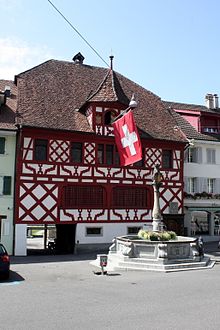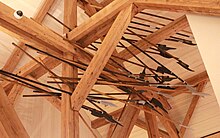Town hall museum Sempach
The Sempach Town Hall Museum is a local history museum in the late medieval town hall of Sempach in the canton of Lucerne . It was reopened in 2014.
town hall
Importance and previous use
The town hall, built from 1474/75 onwards, is a four-story half - timbered building on the main street in Sempach, which is now called "Stadtstrasse". Its location in the center of the village between the two city gates symbolizes the upswing of urban communities in an area that a few decades earlier was still dominated by the castles of Habsburg servants . By 1470, the development of the Lucerne rulership in the countryside, which began in 1386, was completed. Town halls in Sempach and in neighboring Sursee were built almost at the same time . They were not far from the intersection of important trade routes in the Swiss Plateau .
For centuries, the town hall served as an actual multi-purpose building for political and economic purposes: on the ground floor there was a slaughterhouse until the 1830s , while the Tuchlaube on the first floor was used for trading. There were two council chambers above. The large council chamber, today's citizens' hall, is still preserved. Renovation is documented for the years 1636 to 1638.
After the end of the Old Confederation , the town hall was no longer owned by the city, but belonged to the Sempach Corporation. In the years 1887 to 1891 it was extensively renovated by Seraphin Xaver Weingartner , a later renovation took place from 1942 to 1945. Between 1946 and 1955, the seat of the Swiss Ornithological Institute in Sempach was located in the newly furnished offices in the Tuchlaube . In 1971 a small town hall museum was set up in the same rooms.
modification
In 2011, the corporation handed the building over to the newly established City Hall Sempach Foundation. Between 2012 and 2014, the Sempach town hall was renovated again for CHF 4.4 million. The listed building was given a modern concept. With the renovation, the foundation intended to restore the building of national importance to a cultural, economic and political meeting place.
During the construction work, the screed was converted into an attic. A lift, a kitchen and toilets have been installed inside. This means that the town hall can be used not only as a museum, but also as an event location. The separate rooms in the Tuchlaube became a multifunctional hall. In addition, the Rathausbögli, the passage between the alley and the lake side, was reinforced with a pillar for structural reasons. The half-timbered structure on the west facade, which depicts the building history from 1474 to 1887, is now protected by a red construction with a movable lamella curtain.
The foundation, which runs the town hall, and the museum association, which has existed since 1996 and is responsible for the museum, work together.
exhibition
The exhibition, which opened on June 19, 2014, deals with the history of the town of Sempach from the late Middle Ages to the 21st century. The battle of Sempach on July 9, 1386 and the culture of remembrance around the battle are discussed in the attic . During a tour, visitors receive descriptions and further information about the objects on a tablet .
City history
On the ground floor, sacred objects and objects of popular piety, which document everyday religious life in the past, are exhibited in the former archive room of the town hall.
The Tuchlaube illustrates the local history in the areas of trade, craft and trade, transport, politics, construction and agriculture. Two Roman coins from the 1st century AD found in the area can also be seen.
A foyer with a view of Lake Sempach was set up on the second floor next to the Bürgersaal . The showcases located there give an insight into the past of this lake.
Battle history
The exhibition area on the top floor is dedicated to the battle of Sempach and the culture of remembrance. The focus is on the current state of knowledge about the circumstances and the course of the battle, the myth about the battle hero Arnold Winkelried and the change in the annual commemorations. Incidentally, the first mention of a hero comes at the time of the construction of the Sempach town hall, when the Confederates developed a feeling of togetherness during the Burgundian Wars .
A replica of the Winkelriedstein on the battlefield serves as a video station with film recordings from earlier commemorations. Halberds on the ceiling are another allusion to the battle myth.
Citizens' hall with cabinet windows
After the renovation around 1640 , the council chamber on the second floor was equipped with cabinet windows, which are still well preserved today. They were donated by neighboring towns and estates for inauguration. The council chamber was refurnished at the end of the 18th century. Around 1801 it served as a theater.
As a result of the overall historical renovation after the 500th anniversary of the Battle of Sempach, the wood-paneled hall was refurbished in the late Gothic style, based on the example of fragments that were hidden under younger layers of boards. The cabinet panes were framed by slug panes.
The Bürgersaal retained its museum-like character even after the recent renovation of the town hall; only minor technical adjustments were made. In the museum concept, the room stands for politics and representation. It is used for civil weddings, banquets or other events.
The order of the seven cabinet panes on the window, from left to right:
Web links
Individual evidence
- ^ A b Kurt Messmer and Martin Steger: The town hall of Sempach - a multipurpose building from the 15th century , in: Reports! 2014/6 , Monument Preservation and Archeology Canton Lucerne, pp. 6–18.
- ↑ a b c d e Hans-Peter Ryser: 540 years of building history in and around the town hall , in: Reports! 2014/6, pp. 28–53.
- ↑ The town hall is now also a museum , luzernerzeitung.ch, May 10, 2014, accessed on July 13, 2016.
- ↑ Museum ventures into European parquet , in: Festzeitung Sempach 2016 , p. 7.











